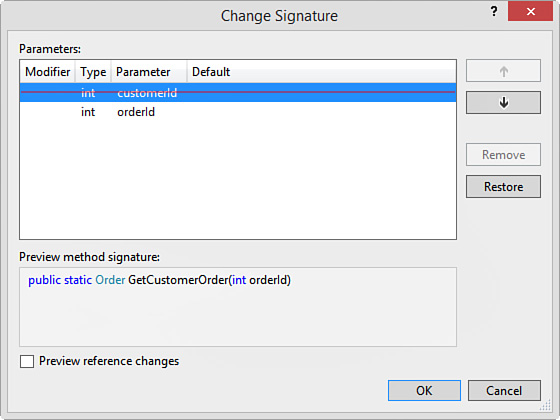 Removing a Parameter
by Mike Snell, Lars Powers
Microsoft Visual Studio 2015 Unleashed, Third Edition
Removing a Parameter
by Mike Snell, Lars Powers
Microsoft Visual Studio 2015 Unleashed, Third Edition
- About This eBook
- Title Page
- Copyright Page
- Contents at a Glance
- Table of Contents
- About the Authors
- Dedication
- Acknowledgments
- We Want to Hear from You!
- Reader Services
- Introduction
- Part I: Introducing Visual Studio 2015
- Chapter 1. A Quick Tour of Visual Studio 2015
- Chapter 2. The Visual Studio IDE
- Chapter 3. The .NET Languages
- What’s New in C# 6.0 and VB 14
- Language Primer
- Language Features
- Infer a Variable’s Data Type Based on Assignment
- Create an Object and Initialize Its Values (Object Initializers)
- Define a Collection and Initialize Its Values
- Creating an Instance of a Nonexistent Class
- Add Methods to Existing Classes (Extension Methods)
- Add Business Logic to Generated Code (Partial Methods)
- Access and Query Data Using the .NET Languages
- Write Simple Unnamed Functions Within Your Code (Lambda Expressions)
- Splitting an Assembly Across Multiple Files
- Working with XML Directly Within Your Code (VB Only)
- Removing Unused Arguments from Event Handlers (VB Only)
- Creating an Automatically Implemented Property
- Dropping the Underscore in VB for Line Continuation
- Working with Dynamic Languages/Objects
- Covariance and Contravariance
- Asynchronous Programming
- The .NET Framework
- Summary
- Part II: An In-Depth Look at the IDE
- Chapter 4. Solutions and Projects
- Chapter 5. Browsers and Explorers
- Chapter 6. Introducing the Editors and Designers
- Part III: Working with the Visual Studio Tools
- Chapter 7. Working with Visual Studio’s Productivity Aids
- Chapter 8. Testing Code
- Chapter 9. Refactoring Code
- Chapter 10. Debugging Code
- Chapter 11. Deploying Code
- Chapter 12. Developing Applications in the Cloud with Windows Azure
- Chapter 13. Working with Databases
- Part IV: Extending Visual Studio
- Part V: Building Web Applications
- Chapter 17. Building Modern Websites with ASP.NET 5
- Chapter 18. Using JavaScript and Client-Side Frameworks
- Chapter 19. Building and Consuming Services with Web API and WCF
- Part VI: Building Windows Client Apps
- Chapter 20. Building Windows Forms Applications
- Chapter 21. Building WPF Applications
- Chapter 22. Developing Office Business Applications
- Part VII: Creating Mobile Apps
- Chapter 23. Developing Windows Store Applications
- Chapter 24. Creating Windows Phone Applications
- Chapter 25. Writing Cross-Platform Mobile Applications with Apache Cordova
- Index
- Code Snippets
Removing a Parameter
You invoke the Change Signature refactor by positioning your cursor inside a method signature and clicking Ctrl+. (or right-clicking and choosing Quick Actions). This Refactor operation enables you to select one or more parameters from a given method, constructor, or delegate and have it (or them) removed from the method. It also allows you to reorder the parameters on the method signature. Of course, once executed, the refactoring operation updates any callers with the new method signature.
Tip
There is another keyboard shortcut to invoke the Change Signature refactoring operation directly. First, position your cursor in the method that contains the parameters you want to remove. Next, play the keyboard chord Ctrl+R, V.
Let’s look at an example. Suppose you have a method with the following signature.
public static Order GetCustomerOrder(int customerId, int orderId)
This method returns an Order object based on both a customer and an order identification number. Suppose you determine that the order ID is sufficient for returning an order. In this case, you invoke Change Signature on the method using Ctrl+. and the resulting light bulb. This brings up the Change Signature dialog, as shown in Figure 9.22. To remove a parameter, you simply select it in the dialog and click the Remove button. In this example, the customerId parameter is crossed out because it is being removed. If you change your mind, you can use the Restore button to cancel individual parameter removals.
When you are ready to make the removal, you can choose to preview the changes or simply apply them all simultaneously. The Preview option works the same as other previews. It shows you each change in a tree view and enables you to see the details behind the change. You can, of course, also uncheck specific changes. When finished, you apply the final set of removals to your code.
Caution
It is common to declare a local variable inside a method and pass that local variable in a call to another method. If you use the refactoring operation to remove the parameter on the method you are calling, the local variable still exists in your calling method. Be careful to make sure that this is what you intended; if not, you have to remove the local variable manually.
-
No Comment
